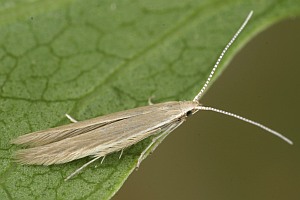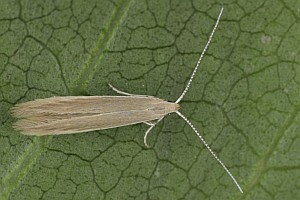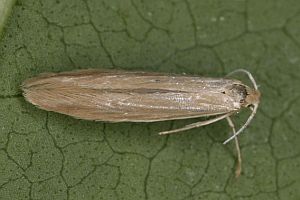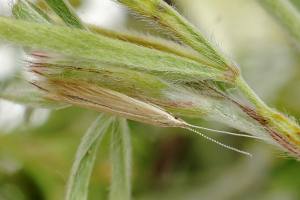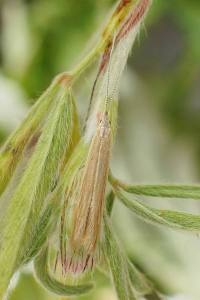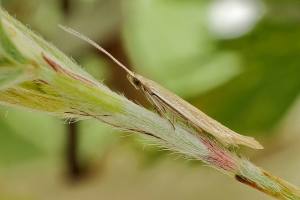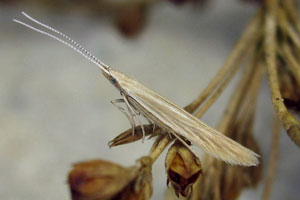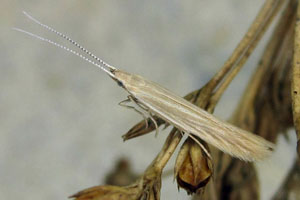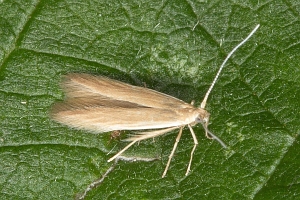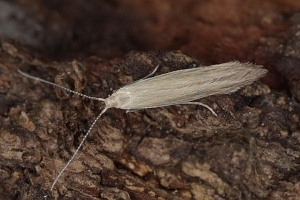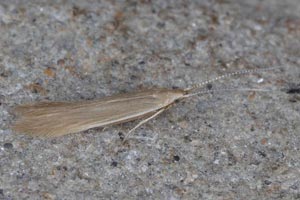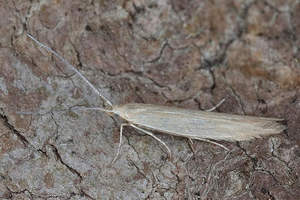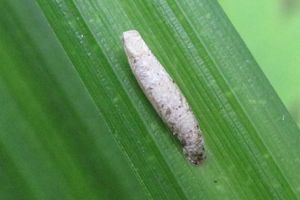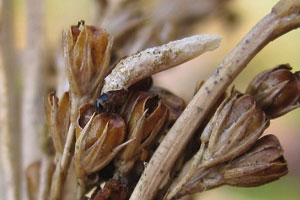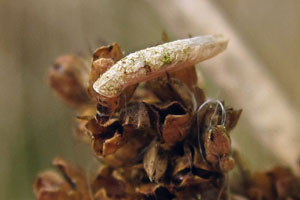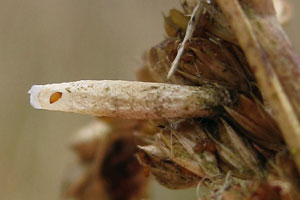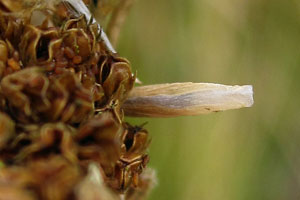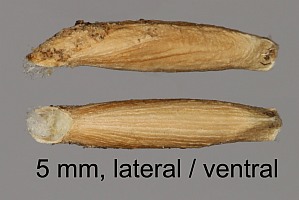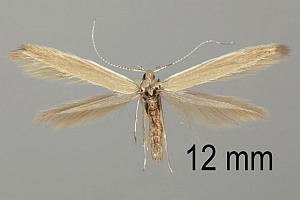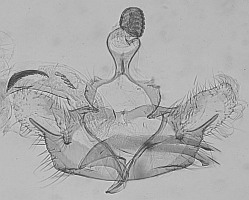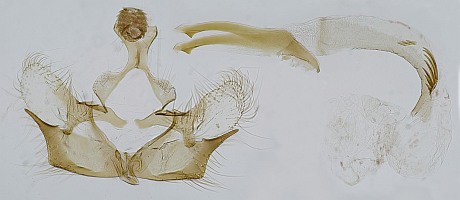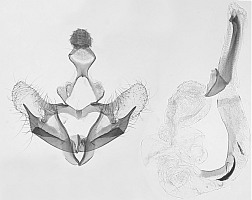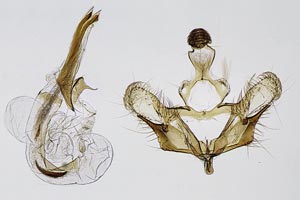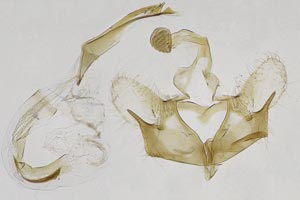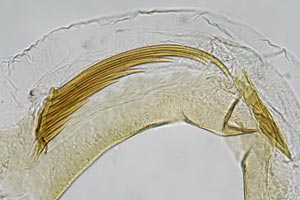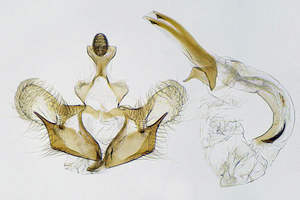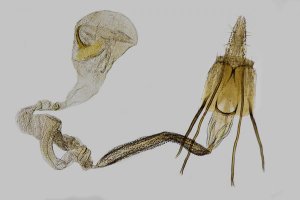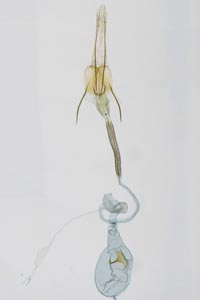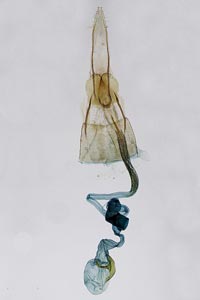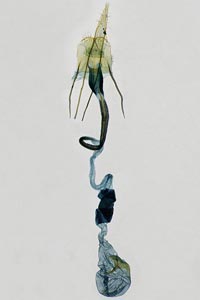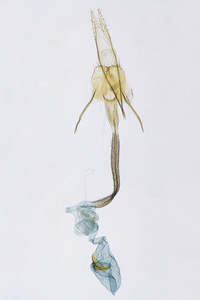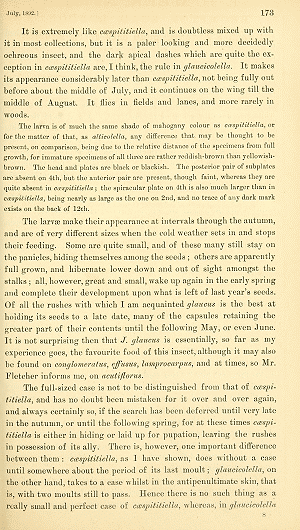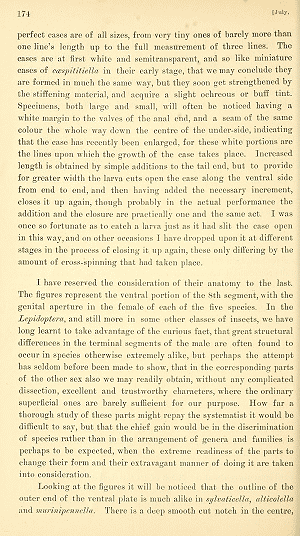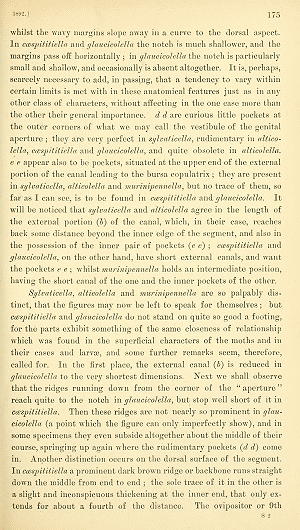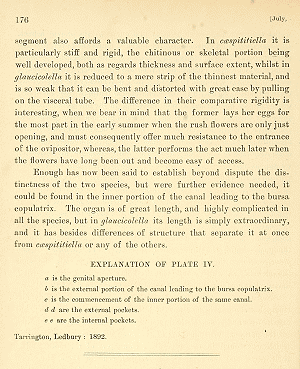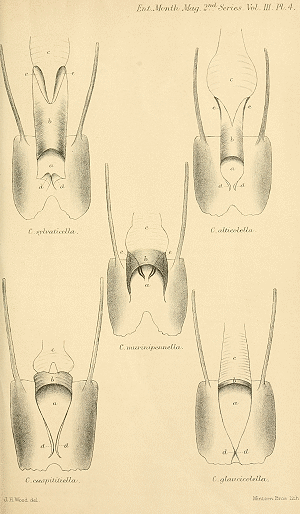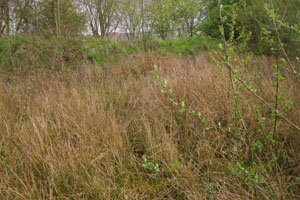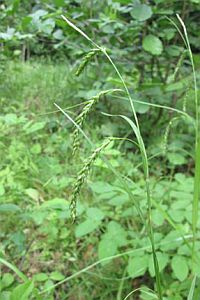

 +44Kontinente:EUASNA
+44Kontinente:EUASNA
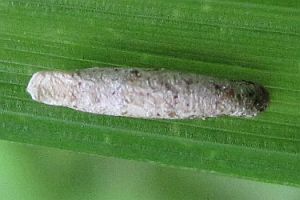

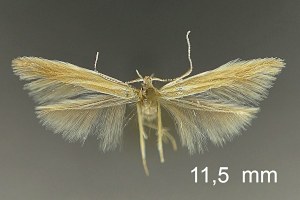
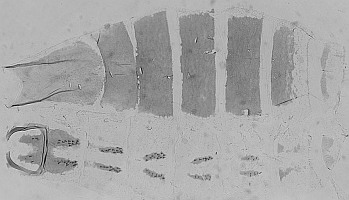
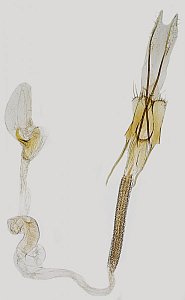

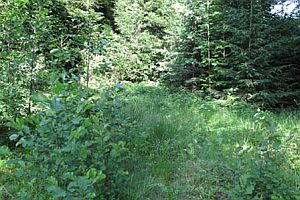
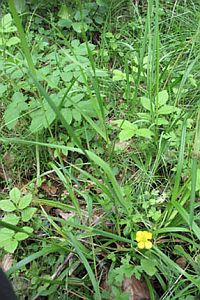
1. Lebendfotos
1.1. Falter
1.2. Raupe, Raupensack
2. Diagnose
Mit einer Vorderflügellänge von ca. 5 mm gehört diese Art zu den kleinen, aufgrund der zeichungsarmen Vorderflügel außerdem zu den sehr unauffälligen Vertretern der Gattung.
2.1. Männchen
2.2. Weibchen
2.3. Genitalien
2.3.1. Männchen
2.3.2. Weibchen
Genitalabbildungen z.B.: Razowski, J.: Motyle (Lepidoptera) Polski 16 - Coleophoridae, p. 199 (♂), p.236 (♀)
2.4. Erstbeschreibung
3. Biologie
3.1. Lebensweise
Die Imagines fliegen vorzugsweise in der Abenddämmerung.
3.2. Habitat
3.3. Raupennahrungspflanzen
Die Raupen leben an verschiedenen Binsen-Arten (Juncus sp.), die Art ist daher v.a. in Feuchtgebieten anzutreffen.
3.4. Nahrung der Raupe
- [Juncaceae:] Juncus inflexus [= Juncus glaucus] (Blaugrüne Binse)
- [Juncaceae:] Juncus articulatus (Glieder-Binse)
- [Juncaceae:] Juncus effusus (Flatter-Binse)
- [Juncaceae:] Juncus conglomeratus (Knäuel-Binse)
- [Juncaceae:] Juncus maritimus (Meerstrand-Binse)
- [Juncaceae:] Juncus acutus (Stechende Binse)
- [Juncaceae:] Juncus gerardii (Salz-Binse, Bodden-Binse, Botten-Binse)
- [Juncaceae:] Juncus subulatus
- [Juncaceae:] Juncus bufonius ??? (Kröten-Binse ???)
- [Juncaceae:] Luzula multiflora (Vielblütige Hainsimse)
Emmet et al. (1996: 324) schreiben zur Eiablage: "Ovum. Laid on a floret of various species of rush (Juncus spp.), especially hard rush (J. inflexus), compact rush (J. conglomeratus), soft rush (J. effusus) and saltmarsh rush (J. gerardii). July-August." Baldizzone (2019: 360) listet auf: "Piante alimentari: Juncus die varie specie (Juncaceae): acutus, articulatus, conglomeratus, gerardii inflexus, maritimus, subulatus." Es werden also weitgehend die selben Arten genutzt wie von Coleophora caespititiella und teilweise auch Coleophora alticolella. Dabei sind die Raupensäcke von C. glaucicolella und C. alticolella praktisch nicht unterscheidbar.
[Bladmineerders.nl] gibt noch zwei wichtige Hinweise: "A reference to Juncus bufonius by Zimmermann & Skala possibly applies to Coleophora lassella." und "Larvae that still need to feed after hibernation are sometimes found on Luzula multiflora." Normalerweise nehmen die Raupen nach der Überwinterung keine Nahrung mehr auf.
(Autor: Erwin Rennwald)
4. Weitere Informationen
4.1. Andere Kombinationen
- Perygra glaucicolella (Wood, 1892) [so bei Anikin et al. (2017)]
4.2. Typenmaterial
Baldizzone (1994: 150) designierte einen Lectotypus: “Lectotypus ♂ [designato in questa sede] conservato al BMNH, reca le seguenti etichette: 1) “Origin.” (a stampa, rotondo, orlato di blu), 2) “Gt. Britain J.H. Wood Coll. B.M. 1966-56” (a mano e stampa), 3) “LECTOTYPE Coleophora glaucicolella Wood teste K.R. Tuck, 1984” (a mano e stampa), 4) “B.M. ♂ Genitalia slide No. 11049” (a mano e stampa).”
4.3. Literatur
- Аникин, В. В. (2021): К фауне молей-чехлоносок (Lepidoptera, Coleophoridae) Дальнего Востока России [Anikin, V. V. (2021): Notes on casebearer moths (Lepidoptera, Coleophoridae) fauna of the Russian Far East]. — Амурский зоологический журнал 13 (3): 319-330.
- Anikin, V.V., Sachkov, S.A. & V.V. Zolotuhin (2017): "Fauna lepidopterologica Volgo-Uralensis": from P. Pallas to present days. — Proceedings of the Museum Witt Munich, Volume 7: 1-696; Munich and Vilnius.
- Lectotypus-Festlegung: Baldizzone, G. (1994): Contribuzioni alla conoscenza dei Coleophoridae LXXV. Coleophoridae dell'Area Irano-Anatolica e regioni limitrofe (Lepidoptera). — Associazione Naturalistica Piemontese Memorie 3: 1-423. Stenstrup (Apollo Books).
- Baldizzone, G. (2019): Fauna d’Italia. Vol. LIII. Lepidoptera Coleophoridae. - XVII + 907 S.; Milano (Calderini).
- Baldizzone, G., Bella, S. & P. Russo (1999): Contributi alla conoscenza della Microlepidotterofauna di Sicilia I. I Coleophoridae del Pantano Longarini (Lepidoptera: Coleophoridae). — Bollettino delle Sedute dell'Accademia Gioenia di Scienze Naturali 32 (356): 83–91.
- Будашкин, Ю. И., Рихтер, И. & Ю. Табель (2015): Новые находки молей-чехлоносок (Lepidoptera: Coleophoridae) в России и в Армении. — Эверсманния 41: 11–22.
- Emmet, A.M., Langmaid, J.R., Bland, K.P., Corley, M.F.V. & J. Razowski (1996): Coleophoridae. - S. 126-338. In: Emmet, A.M. [Hrsg.](1996): The moths and butterflies of Great Britain and Ireland. Volume 3. Yponomeutidae - Elachistidae. - 452 S.; Colchester, Essex.
- Фалькович, М. И. (1992): К фауне чехлоносок (Lepidoptera, Coleophoridae) южной Туркмении (с описанием новых видов) Часть 2. — Труды Зоологического института Российскии Академии Наук 248: 96-126.
- Фалькович, М. И. & С. Я. Резник (1980): Результаты зоологических иссиледований Доктора З. Касаба в Монголии. 444. Список видов семейства чехлоносок (Lepidoptera, Coleophoridae) [Falkovitsh, M. I. & S. J. Reznik (1980): Ergebnisse der zoologischen Forschungen von Dr. Z. Kaszab in der Mongolei. 444. Verzeichnis der Coleophoriden-Arten (Lepidoptera)]. — Насекомые Монголии 7: 366-377.
- Li, H. & L. Zheng (1999): Three new species and seven newly recorded species of the genus Coleophora from China (Lepidoptera: Coleophoridae). — Acta Scientiarum Naturalium Universitatis Nankaiensis 32 (3): 189-194.
- Erstbeschreibung: Wood, J. H. (1892): Our rush-feeding Coleophorae. — The Entomologist's Monthly Magazine 28 (= Second series 3): 117-122, 169-176 + pl. 4. London (Gurney & Jackson).










































